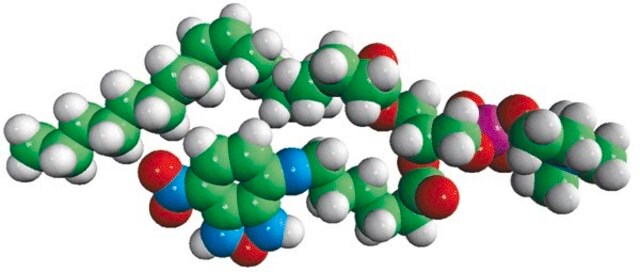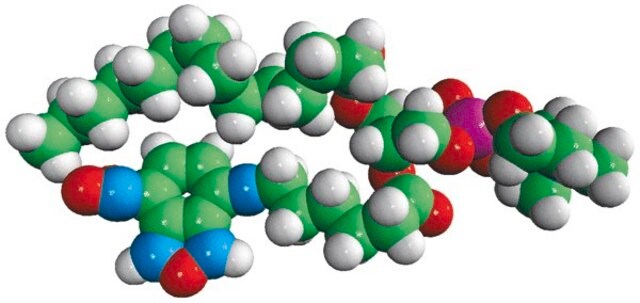810122C
Avanti
14:0-06:0 NBD PC
Avanti Research™ - A Croda Brand 810122C
Synonym(s):
1-myristoyl-2-{6-[(7-nitro-2-1,3-benzoxadiazol-4-yl)amino]hexanoyl}-sn-glycero-3-phosphocholine
About This Item
Recommended Products
Assay
>99% (TLC)
form
liquid
packaging
pkg of 1 × 1 mL (810122C-1mg)
pkg of 5 × 1 mL (810122C-5mg)
manufacturer/tradename
Avanti Research™ - A Croda Brand 810122C
concentration
1 mg/mL (810122C-1mg)
1 mg/mL (810122C-5mg)
shipped in
dry ice
storage temp.
−20°C
General description
Application
- as a supplement in ice-cold synthetic defined (SD) medium for yeast cultures for flow cytometry studies
- as a fluorescent marker in hyaluronan-phospholipid based medium (HA–phospholipid medium) for culturing cartilage cells and to visualize lipid vesicle formation
- in the preparation of small unilamellar vesicles (SUVs) and fluorescence-labeled supported lipid bilayer (SLB) for fluorescence recovery after photobleaching (FRAP) studies
Biochem/physiol Actions
Packaging
Legal Information
Signal Word
Danger
Hazard Statements
Precautionary Statements
Hazard Classifications
Acute Tox. 3 Inhalation - Acute Tox. 4 Oral - Carc. 2 - Eye Irrit. 2 - Repr. 2 - Skin Irrit. 2 - STOT RE 1 - STOT SE 3
Target Organs
Central nervous system
WGK
WGK 3
Choose from one of the most recent versions:
Certificates of Analysis (COA)
Sorry, we don't have COAs for this product available online at this time.
If you need assistance, please contact Customer Support.
Already Own This Product?
Find documentation for the products that you have recently purchased in the Document Library.
Our team of scientists has experience in all areas of research including Life Science, Material Science, Chemical Synthesis, Chromatography, Analytical and many others.
Contact Technical Service










